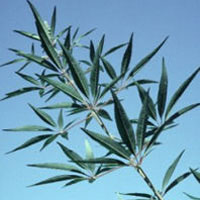health guides
Agnus Castus
 © Steven Foster
© Steven FosterHow It Works
Agnus Castus contains a few different constituents, including flavonoids, iridoid glycosides, and terpenoids. The whole fruit extract, rather than one of its individual constituents, appears to be necessary for the medicinal activity of agnus castus.1 Agnus Castus does not contain hormones. The benefits of agnus castus stem from its actions upon the pituitary gland—specifically on the production of a hormone called luteinizing hormone (LH). This indirectly increases progesterone production and helps regulate the menstrual cycle. Agnus Castus also keeps prolactin secretion in check.2, 3 The ability to decrease mildly elevated prolactin levels may benefit some infertile women as well as some women with breast tenderness associated with premenstrual syndrome (PMS).
A controlled clinical trial found that women taking 20 mg per day of a concentrated agnus castus extract for three menstrual cycles had a significant reduction in symptoms of PMS, including irritability, mood swings, headache, and breast tenderness.4 Another double-blind trial found that women taking agnus castus had slightly greater relief from symptoms of PMS, including breast tenderness, cramping, and headaches, than those taking vitamin B6.5 These trials support the findings of preliminary agnus castus trials for women with PMS.6, 7 Agnus Castus (32.4 mg per day), in combination with some homoeopathic remedies, has also been found in a double-blind trial to successfully treat breast tenderness (also called mastalgia).8
A review of other trials and case reports suggests there is at least preliminary support that agnus castus should be considered for women with irregular periods, infertility, and mildly elevated prolactin levels.9 Double-blind trials have confirmed the effectiveness of agnus castus at lowering mildly elevated prolactin levels in women.10 According to one small trial, acne associated with PMS, may also be reduced using agnus castus.11
How to Use It
Caution: Agnus castus should not be taken during pregnancy. The German Commission E monograph recommends a daily intake—30–40 mg of the dried herb—in capsules or in liquid preparations.12 Agnus Castus is typically taken once in the morning with liquid for a few months consecutively.
With its emphasis on long-term balancing of a woman’s hormonal system, agnus castus is not a fast-acting herb and is unlikely to give immediate relief to the discomfort associated with PMS. For premenstrual syndrome, frequent or heavy periods, agnus castus can be used continuously for four to six months. Infertile women with amenorrhoea (lack of menstruation) can remain on agnus castus for 12 to 18 months, unless pregnancy occurs during treatment.
Copyright © 2024 TraceGains, Inc. All rights reserved.
Learn more about TraceGains, the company.
The information presented by TraceGains is for informational purposes only. It is based on scientific studies (human, animal, or in vitro), clinical experience, or traditional usage as cited in each article. The results reported may not necessarily occur in all individuals. Self-treatment is not recommended for life-threatening conditions that require medical treatment under a doctor's care. For many of the conditions discussed, treatment with prescription or over the counter medication is also available. Consult your doctor, practitioner, and/or pharmacist for any health problem and before using any supplements or before making any changes in prescribed medications. Information expires December 2024.


 We are proud to announce that
We are proud to announce that  As the market evolves, customers increasingly request a wider variety of omega-3 options for their lipid...
As the market evolves, customers increasingly request a wider variety of omega-3 options for their lipid...  Maintaining healthy glucose levels is crucial for preventing metabolic conditions like diabetes,...
Maintaining healthy glucose levels is crucial for preventing metabolic conditions like diabetes,...  Looking at formulating a new vitamin blend? Discover
Looking at formulating a new vitamin blend? Discover 







































